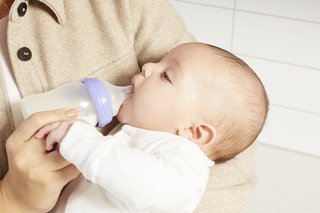Bottle feeding your baby
The early days with your baby are a great time to get to know each other. This can be done by keeping your baby close to you when you bottle feed, enjoying skin contact.
Babies will feel more secure if most feeds are given by parents or main caregivers, especially in the early weeks, as this will really help you bond with each other.
How to bottle feed
Make sure that you're sitting comfortably. Always hold your baby close to you and look into their eyes when feeding – this helps your baby feel safe and loved.

1. Feed your baby when they show signs of being hungry, look out for early cues (moving head and mouth around, sucking on fingers).
Crying is the last sign of wanting to feed, so try and feed your baby before they cry.

2. Hold your baby close in a semi-upright position so you can see their face and reassure them by looking into their eyes and talking to them during the feed. Begin by inviting your baby to open their mouth by gently rubbing the teat against their top lip.

3. Gently insert the teat into your baby's mouth, keeping the bottle in a horizontal position (just slightly tipped) to prevent milk from flowing too fast.
If the teat becomes flattened while you are feeding, pull gently on the corner of your baby's mouth to release the vacuum.

4. Watch your baby and follow the cues for when they need a break; these signs will be different from one baby to the next. They may splay their fingers and toes, spill milk out of their mouth, stop sucking, turn their head away or push the bottle away.
Gently remove the teat or bring the bottle downwards to cut off the flow of milk.

5. Your baby may need short breaks during the feed and may need to burp sometimes. When your baby does not want any more feed, hold them upright and gently rub or pat their back to bring up any wind.
What not to do when bottle feeding
-
Never force your baby to finish a feed as this will be distressing and can mean your baby is overfed. Your baby will know how much milk they need.
-
Never leave your baby alone to feed with a propped-up bottle as they may choke on the milk.
-
Never feed your baby while they are in a sling or carrier. Take them out of the sling first so they're in a safe feeding position.
How much formula is enough?
Your baby's weight gain and the number of wet and dirty nappies will help tell you if your baby is getting enough formula.
How often should my baby pee and poo?
For the first few days after birth, your baby will pass dark, sticky poo called meconium. Then after the first week, your baby's poo will be more of a pale yellow or yellowish-brown.
Expect your baby to produce around 6 wet nappies a day. These nappies should be heavy with clear or pale-yellow urine.
Every day, your baby should have at least 6 wet nappies and at least one soft poo.
If you are concerned your baby is not getting enough milk, speak to your midwife or health visitor.